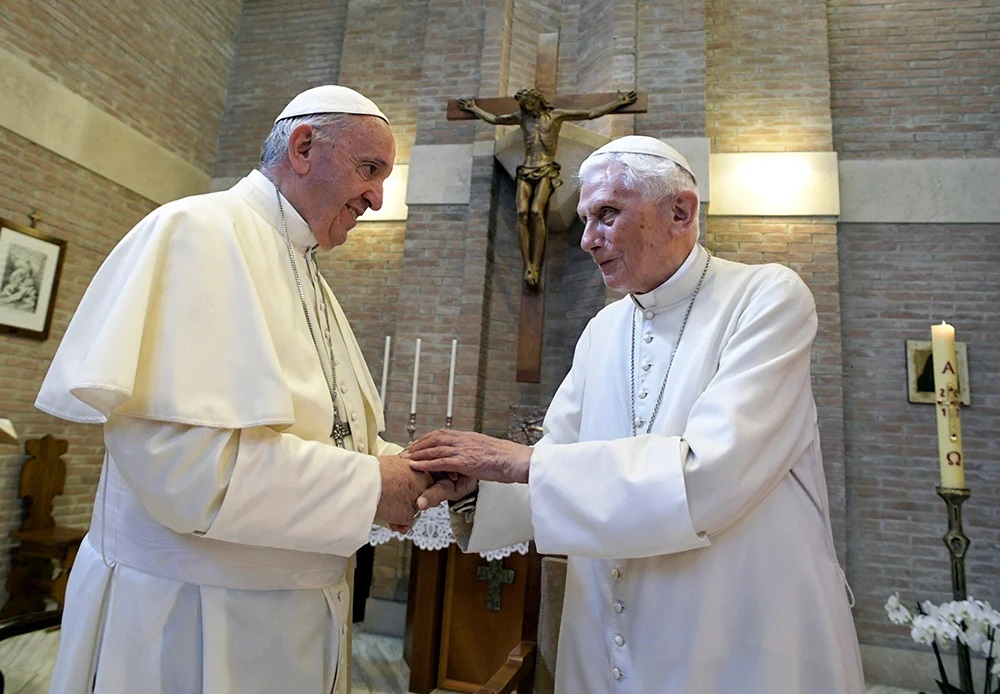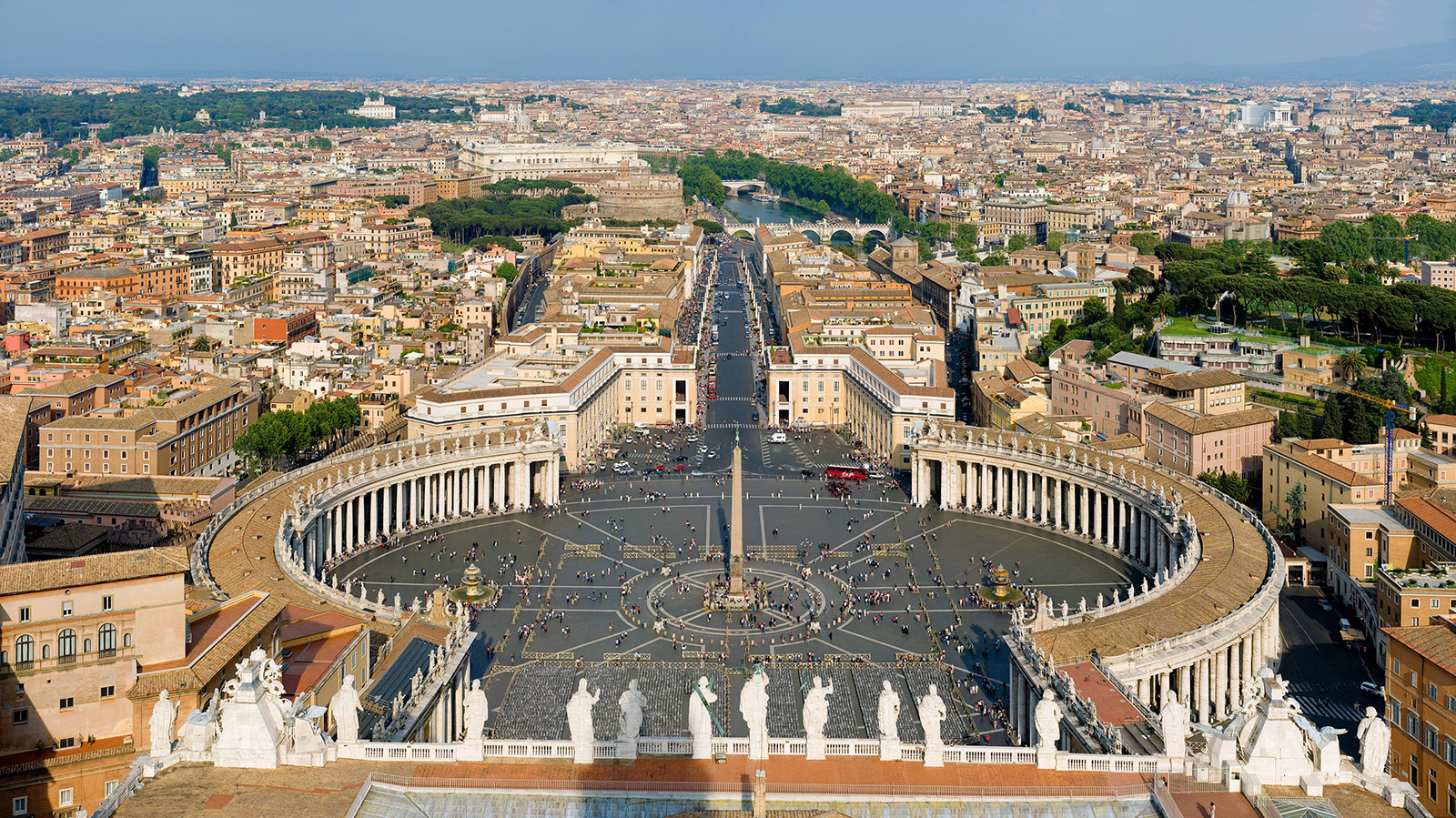VATICAN CITY (VATICAN CITY)
Religion News Service - Missouri School of Journalism [Columbia MO]
March 5, 2021
By Claire Giangravé
A perfect storm of institutional crises, the polarization of perceived winners and losers and an influx of evangelicals has made Catholicism fertile ground for conspiracy theories.
If it’s true that all roads lead to Rome, it’s also true that in one way or another, all conspiracy theories lead to the Vatican.
Be it the illuminati, aliens or even a time machine buried in its hidden archives, the Vatican has been a favored subject for conspirators thanks to its penchant for secrecy and a talent for smoke and mirrors.
But a new wave of conspiratorial thinking, especially among Catholic conservatives, is changing the face of the Catholic Church today, experts say.
A perfect storm of institutional crises, the polarization of perceived winners and losers under Pope Francis’ pontificate and the migration of evangelicals into the church has created a fertile ground for conspiracy theories, especially about papal authority.
“In recent years, the number and volume of conspiracy culture in Catholicism has grown,” said Massimo Faggioli, professor of theology and religious studies at Villanova University.
In 2018, Catholic conservatives found a champion in Archbishop Carlo Maria Viganò, who released a scathing 11-page letter accusing Francis and other high-ranking prelates of covering up sex-abuse allegations against ex-Cardinal Theodore McCarrick. Viganò’s allegations, only loosely based on facts, were refuted in a 449-page Vatican report.
But since then, the archbishop has embraced apocalyptic language, calling for “the children of light” to fight looming forces of darkness in the Vatican.
The following year, a prayer ceremony held in the pope’s gardens during the synod for the Amazon region involved tribal representatives from the Amazon bowing before wooden carvings of pregnant women. That spurred allegations that Francis had endorsed idolatry and paganism.
In early January of this year, false reports that Pope Francis had been arrested for child trafficking spread like wildfire over the internet, echoing bizarre allegations against politicians in the U.S. made by followers of the shadowy internet figure Q.
Geoff Dancy, a professor at Tulane University who has studied the phenomenon in the United States, said that many conspirators start with factual truths and real-life events. “But conspiratorialism is seeing conspiracies everywhere, even when it doesn’t necessarily make sense or it doesn’t bear out with evidence,” he said.

According to Dancy, the current situation at the Vatican provides the perfect environment to breed conspiratorial thinking. Drawing from a seminal collection of essays on conspiracy theories by Richard Hofstadter, “The Paranoid Style in American Politics,” Dancy said that moments of deep crisis can trigger conspiracy theories.
Others connect conspiratorial thinking to losers’ grievances, he said, meaning that “people who have lost political power, often turn quickly to conspiracy theories.”
There is no doubt that the Catholic Church checks both boxes. It faces deep institutional crises relating to the sexual abuse and financial scandals and harbors a crowd of disappointed Catholics opposed to Francis’ papacy, mostly conservatives who look back to the heyday of Pope John Paul II, the popular Polish pope who was credited for having a pivotal role in the defeat of Communism.
“There were no sex scandals. Everything was great,” said Dancy, who was raised Catholic. “Where are we 25 years after that? Not looking so hot, right?”
Conservative Catholics were given prime positions at the Vatican under John Paul, often wagging their finger at progressives clinging to the precepts of the Second Vatican Council and liberation theology and its premium on openness, inclusion and ecumenism.
In John Paul’s later days, the catastrophic effect of the clerical sex-abuse scandals, Vatileaks and reports of financial malfeasance at the Vatican generated a growing sense of distrust toward Catholic institutions, which culminated with the shock of the resignation of John Paul’s successor, Pope Benedict XVI.
For some Catholics, Benedict remains the one true pope, forced to step down by greater powers at work. Despite frequent statements by Benedict and cozy photos of the two, Francis and his predecessor’s attempts to stress the continuity of the pontificate, the conservative ex-pope is seen in some corners as the real spiritual leader of the church.
“Some of my fanatic friends are still a bit angry, they didn’t want to accept my decision. I think of the conspiracy theories that followed,” the Emeritus pope told Italian daily, Corriere della Sera, recently. “There aren’t two popes, the pope is only one,” he added.
It doesn’t help that Francis embodies the darkest fears of the church’s conservative thinkers. The Argentine pope is rooted in liberation theology, which swept through Latin America in the ’60s, and as a Jesuit he is part of the plot to “bring a new sort of thinking into the heart of the Church,” as Viganò put it.
While loyalty to the pope is what sets Catholicism apart from other Christian denominations and has been paramount for conservatives especially, the conspiracy talk has served to put daylight between the papacy and Francis’ policies, Dancy said. “If you do think, doctrinally, that the pope is the Vicar of Christ, then first you’ve got to delegitimize the pope before you can speak out against him.”
Conspiracy theories are not the prerogative of the conservative mindset. “Conspiratorialism is actually attached to progressivism,” Dancy pointed out. What spurs conspiracy theories is the idea that progressive change can happen very quickly, he explained, were it not for a small group of persons preventing it, who thus become “the embodiment of evil.”
“If you have an unreasonable faith in your own agency, or your ability to change something, then it lends itself to conspiratorial thinking,” Dancy explained.
The prevalence of conservative conspiratorialism in the Catholic Church has much to do with politics, and particularly the politics of the United States. “I guarantee, the Venn diagram of Catholic conservatives who loved (former President Ronald) Reagan and loved John Paul II, is almost an exact circle,” Dancy said. Both groups are prone to see conspiracy theories as signs of a return to a halcyon past.
The same church-state parallel is hard to miss in Viganò’s “nostalgia for the return to intimacy with the divine” in the fight against the self-proclaimed “prophets of a better future,” and Donald Trump’s efforts to “Make America Great Again.”
Faggioli believes that in the United States, the Catholic Church has changed “due to an influx of converts from the evangelical, Protestant faith that brings into Catholicism a millenarian, apocalyptic culture that is not native to Catholicism.”
Photo above: A view of St. Peter’s Square, Vatican City, and Rome from the top of Michelangelo’s dome in St. Peter’s Basilica. Photo by David Iliff/Creative Commons/CC BY-SA 3.0
According to Pew Research Center data from 2015, roughly 2% of cradle American evangelicals have converted to Catholicism in recent decades. While a small cohort, many of the loudest and most vehement opposition to Francis comes from formerly Protestant converts.
Protestant influence in American Catholicism has led to a “sectarian view,” Faggioli said. “The problem is, do you believe in the Vatican version of certain events or what you read in your favorite blog?”
The proliferation of independent media outlets outside of the Vatican’s influence has provided a platform for dissenting views, from successful blogs such as Church Militant, which in the past has entertained far-fetched or unproven reporting, to the conservative media colossus EWTN.
“The changes in the mediatic ecosystem, independent Catholic media and the rise of social media have opened Pandora’s box,” Faggioli said.
Likening opposition to Francis to Disney’s “Sorcerer’s Apprentice,” Faggioli believes that the tactics adopted by conservative conspiracy theorists may turn against them. By allowing the growth of conspiracy theories undermining a legitimately elected pope, Faggioli said, “you break the last taboo.”
“What they didn’t realize is that if you do that, then it’s open season on everyone,” he added.
